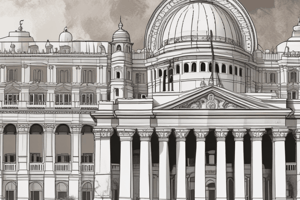Podcast
Questions and Answers
Who serves as the chairperson of the Rajya Sabha in India without voting rights, except in case of a tie?
Who serves as the chairperson of the Rajya Sabha in India without voting rights, except in case of a tie?
- President
- Prime Minister
- Vice President (correct)
- Supreme Court Judge
Which entity in the Indian political system is responsible for interpreting and applying the Constitution?
Which entity in the Indian political system is responsible for interpreting and applying the Constitution?
- Vice President
- Prime Minister
- President
- Supreme Court (correct)
In India's political system, who is selected based on the party or coalition holding the majority seat count after general elections?
In India's political system, who is selected based on the party or coalition holding the majority seat count after general elections?
- President
- Prime Minister (correct)
- Supreme Court Judge
- Vice President
Which governing entity in India is responsible for ensuring cooperation between different ministries and departments?
Which governing entity in India is responsible for ensuring cooperation between different ministries and departments?
In India, under what conditions can the President dissolve the lower house?
In India, under what conditions can the President dissolve the lower house?
Who holds tenure until retirement age in the Indian Supreme Court?
Who holds tenure until retirement age in the Indian Supreme Court?
Which of the following is NOT true about the Indian Parliament?
Which of the following is NOT true about the Indian Parliament?
What role does the President of India primarily play in the government structure?
What role does the President of India primarily play in the government structure?
Which position in India's political system is described as having a role that is primarily symbolic?
Which position in India's political system is described as having a role that is primarily symbolic?
What distinguishes the Lok Sabha from the Rajya Sabha in the Indian Parliament?
What distinguishes the Lok Sabha from the Rajya Sabha in the Indian Parliament?
Which institution in India's political system is responsible for ratifying international treaties?
Which institution in India's political system is responsible for ratifying international treaties?
Among the Vice President, Prime Minister, and President, who has a more directly involved role in shaping national policies in India?
Among the Vice President, Prime Minister, and President, who has a more directly involved role in shaping national policies in India?
Flashcards are hidden until you start studying
Study Notes
India's Political System: A Comprehensive Overview
At the heart of India's dynamic democracy lies a complex yet well-established set of institutions designed to govern one of the world's most populous countries. In this article, we delve into key components of India’s political system—the legislature, presidency, prime ministership, vice presidency, and judiciary.
The Legislature
The Indian Parliament is bicameral, consisting of two Houses—the Rajya Sabha and the Lok Sabha. The Rajya Sabha consists of members nominated by state governments and elected representatives from each state. Its members serve six years with half the seats up for election every three years. On the other hand, the Lok Sabha, which translates to 'House of People,' comprises directly elected members representing individual constituencies across India. Members of both houses work together to pass laws and formulate national policies, making them powerful players in shaping the country's future.
President
As head of state, the President represents India domestically and internationally, holds ceremonial powers such as receiving foreign dignitaries and ratifying international treaties, and has certain executive functions. Although the role is primarily symbolic, it plays a crucial part in maintaining stability and balance within the government structure. For instance, the President may dissolve the lower house under specific conditions if requested by the leader of the House, who must have support from either two-thirds of its total membership or a simple majority when supported by 1/4th of the total membership for over four months.
Prime Minister
The Prime Minister is selected based on the party or coalition holding the majority seat count after general elections. As the chief advisor to the president, they guide policy decisions while ensuring cooperation between different ministries and departments. They also represent India at various global platforms, much like the President does. While nomination requires the backing of a majority vote in parliament, their real power stems from successfully forming coalitions and managing existing ones.
Vice President
The Vice President serves as the chairperson of the Rajya Sabha without voting rights unless there's a tie in votes. Their primary responsibility involves presiding over proceedings and coordinating activities among councilors during meetings. The position rotates between parties represented in the upper chamber, with the current incumbent serving a five-year term.
Supreme Court
Lastly, let us explore the highest court of law in India, known as the Supreme Court. It interprets and applies the Constitution of India as well as ensures compliance from all levels of government. Judges appointed to the top court hold tenure until retirement age. Unlike popular misconception, judges do not serve life terms; rather, they retire at 65 years old. This institution plays a critical role in protecting citizens' fundamental rights, acting as a safeguard against arbitrary actions taken by the government or any public servant.
In summary, India's political system embodies an interconnected web of governing entities, including parliament, presidency, prime ministry, vice presidency, and supreme court. Each entity performs distinct roles to ensure the smooth functioning of India's diverse democratic landscape.
Studying That Suits You
Use AI to generate personalized quizzes and flashcards to suit your learning preferences.





